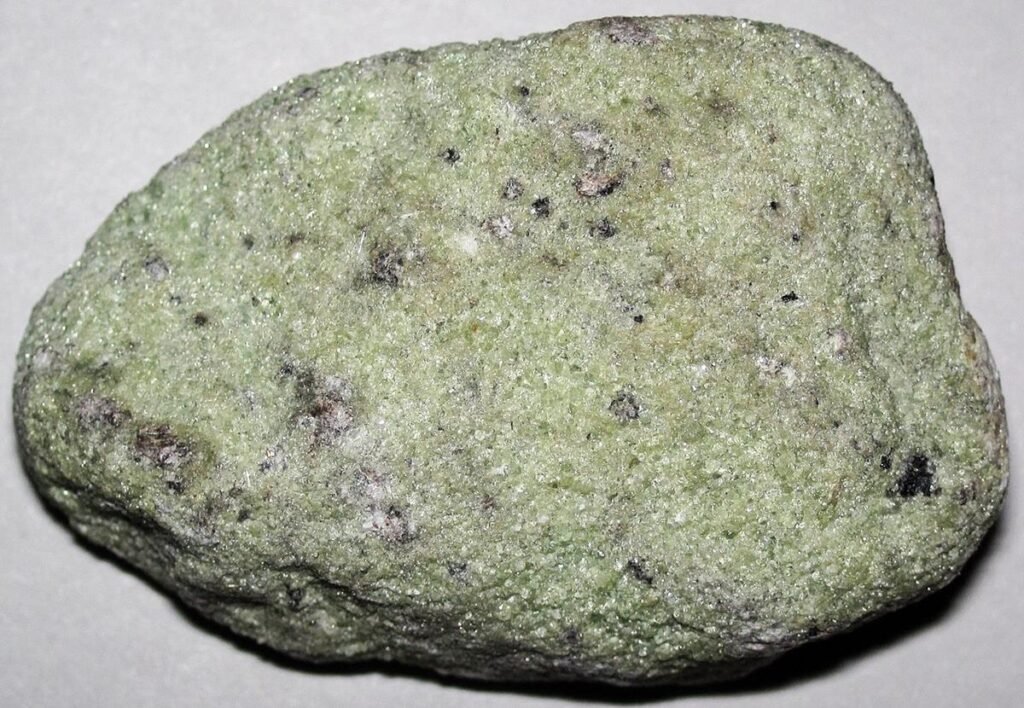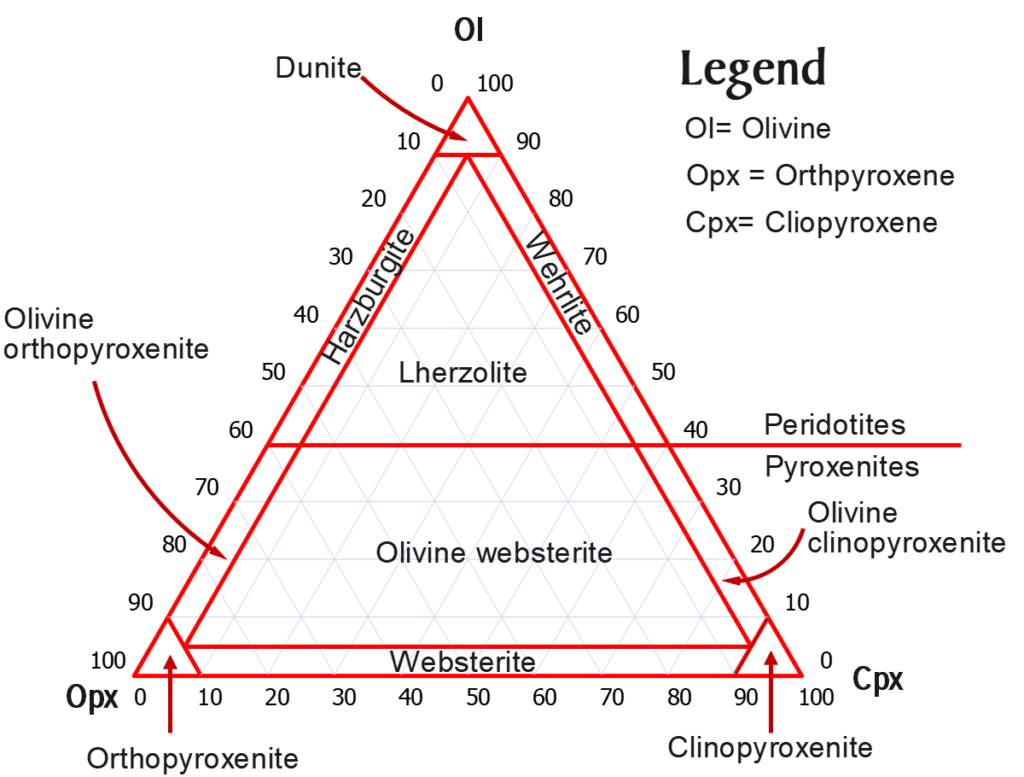Dunite is an ultramafic plutonic or intrusive igneous rock in which olivine exceeds 90% by volume. Ultramafic means it has at least 90% mafic minerals. Mafic minerals are dark minerals rich in iron and magnesium.
On the other hand, plutonic or intrusive means it formed deep in the Earth’s crust. Therefore, it cooled slowly, forming large crystals or a coarse-grained (phaneritic) texture.
Dunite is one of the peridotites together with kimberlite, wehrlite, lherzolite and harzburgite. Peridotites are ultramafic rocks with at least 40% olivine by volume that dominate the Earth’s upper mantle layer.
The color of fresh dunite rock is light, olive, or dark green due to its high olivine content. However, it quickly alters when on the Earth’s surface, making it tan or reddish brown.
Also, this rock will quickly undergo retrograde metamorphism to form serpentinite and soapstone under near-surface conditions. Retrograde metamorphism is a mineralogical change in response to a reduction in temperature and pressure.
Lastly, some of the physical properties of dunite include a Mohs hardness of 6-7 and a density of about 3.2-3.5g/cm3.

Chemical composition
Dunite is a silica-poor, ultrabasic rock with less than 45 wt.% silica. It is relatively high in iron and magnesium oxides and low in calcium and alkali oxides (sodium and potassium).
Also, it usually has a high iron-to-magnesium ratio.
Mineral composition
Dunite has over 90% by volume to almost entirely magnesium-rich olivine with a chemical formula (Mg, Fe)2SiO4. Accessory minerals common in this rock include pyroxenes, chromite, pyrope, magnetite, hornblende, and ilmenite.

Formation
It is a fact that dunite and other peridotites or ultramafic rocks comprise the upper mantle. Their fragments (xenoliths) in kimberlites and basalts serve as solid evidence.
Also, the magnesium-rich olivine in dunites melts at about 3270°F (1800°C). Such temperatures aren’t achieved in the crust or even the upper mantle.
Therefore, it is sensible to say this rock doesn’t crystallize directly from magma melt as basalt does due to the high crystallization temperatures.
Furthermore, since it is almost entirely olivine, it is not directly from magma solidification as single mineral magmas don’t exist in nature.
How else does dunite form? Here are possible explanations for their formation.
1. Refractory residue
Harzburgite or lherzolite are peridotite rocks dominated by olivine and have considerable orthopyroxene and clinopyroxene.
Partial melting and extraction of basaltic magma from these rocks will dissolve orthopyroxenes and clinopyroxenes. This will progressively leave behind more and more an olivine-enriched rock.
If most orthopyroxenes or clinopyroxenes are depleted, you will have dunite, a rock made almost entirely of olivine.
In this case, dunite is a refractory residue, i.e., the remnant portion that didn’t melt.
The presence of dunite and other ultramafic xenoliths in basaltic magma is evidence. The quick-rising magma entrains and prevents these xenoliths from sinking as they are denser.
2. They form as cumulates
Some basaltic magma mushes like picritic are enriched with olivine. Being denser, olivine may sink and settle at the bottom, forming a layer. Any interstitial magma in this layer will also crystallize under equilibrium if it doesn’t further fractionate.
This is how layered dunites in mafic and ultramafic layered intrusions form. Also, dunite layers in ophiolites probably form in the same way.
Ophiolites are part of an ancient oceanic crust, and the upper mantle emplaced onto the continental crust.
Lastly, cumulate dunites often occur with other cumulates like harzburgite, chromitite, wehrlite, or olivine pyroxenite.
Where is dunite found?
Dunite occurs in ophiolites and small to massive layered mafic intrusions of any age. These intrusions can be sills or sill-like, dikes, lenses, or pipes. Also, a small amount occurs as xenoliths in basaltic magmas.
Twin Sisters Mountain in Washington, US, has a massive exposure, mostly unaltered dunite. It formed from a nappe, i.e., thrust fault uplift activity. Other places with this rock in the US are Palisade Sill in New York, Stillwater Igneous Complex in Montana, and Chugach Mountains in Alaska.
Besides the US, dunite also occurs at Dun Mountain in New Zealand, Näränkävaara intrusion in Finland, Skaergaard complex in Greenland, Bushveld Igneous Complex (South Africa), Great Dyke (Zimbabwe), and Troodos Ophiolite in Cyprus and Muskox intrusion in Canada.
Some of the layered intrusions, like Näränkävaara, Great Dike, Still Water, and Muskox, are massive, with some having dunite layers over a kilometer thick.
What are the uses of dunite?
Dunite uses include carbon dioxide sequestration, agriculture, and industries. Also, it may host valuable mineral ores.
Here is more on these uses:
1. Carbon dioxide sequestration
A potential use of dunite rock is atmospheric carbon dioxide sequestration or capture. Olivine in this rock reacts with carbon dioxide according to this equation: Mg2SiO4 (olivine) + 2CO2 = 2MgCO3 (magnesite) + SiO2 (silica).
This will reduce global warming caused by this greenhouse gas, and hydraulic fracture and drilling will speed up the process.
Lastly, the resulting products can be of economic value.
2. Industrial uses
In industries, there is a rising trend in using dunite and pyroxenite in sintering and as a fluxing agent in metallurgical blast furnaces instead of dolomite.
Also, it can make refractory bricks since it has a high temperature and low expansion coefficient.
Another use is a cement additive (1).
3. Agricultural and environment
In agriculture, dunite can work as a fertilizer or fix soil pH. Also, a study notes that its byproduct or mining waste can improve polluted soils.
4. Valuable ores
Some dunite rocks may host valuable ores. These include chromite (a source of chromium), platinum-bearing nickel sulfide, magnetite, perovskite, and copper sulfide.
Frequently asked questions
Dunite rock was named after Mount Dun ophiolite in New Zealand, its type locality, by an Austrian geologist, Ferdinand von Hochstetter. Dun describes the reddish brown or tan color the mountain has from the oxidation of olivine in this rock.
No. It isn’t a good choice for construction, architectural, or ornamental decorations like sculptures. It quickly alters and undergoes weathering when exposed to surface conditions.
